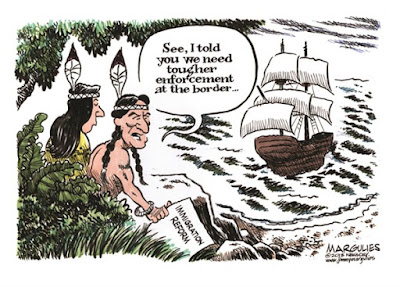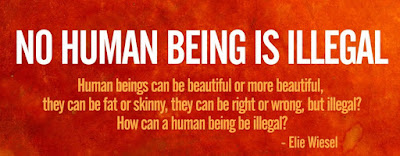2.3 Undocumented Immigrant
Undocumented immigrant as known as illegal alien is a people who across national borders in a way that violates the immigration laws of the destination country. Study shows that most of them are young adults and they are tend to be poorly educated. Some countries have million of immigrants. For example, in United States, there were 2.6 million undocumented immigrants resided in California in 2010 and increased by an average of 500,000 per year (Johnson et al. 2011). Those immigrants believe that the benefits of successfully immigrating are greater than the risk, thus, illegal immigration is becomes an option. Otherwise, not all illegal immigrants are crossing into one country to find work. Law enforcement officials of the United State indicate that are individuals coming across the border who are forced to leave their home countries because of criminal activities, such as drug smuggling, human trafficking and identify theft (nccivitas.org). Anti-immigration in United State claimed that local, state, and federal government are burdened with increased costs billions of dollars through their utilization of educational and social systems such as primary and secondary education, health, care programs, emergency rooms, and other anti-poverty programs to which they don’t contribute through taxes.
According to Becerra et al. (2012) study shows otherwise: what is claimed by anti-immigrants was a negative depiction of undocumented immigrants, which is based on exaggerations, the distortion of data, or incomplete information, that have created a hostile environment for undocumented immigrants. In addition, many of undocumented immigrants contribute to the economic through taxes. They pay Social Security and other taxes, but do not collect benefits, and they are not eligible for many government services. Becerra (2012) takes Texas as an example, his study reported that undocumented immigrants provided $17.7 billion in gross state product, If all undocumented immigrants in Texas were to leave or be deported, not only would Texas lose over $400 million in state revenues, but Texas would also lose 2,3% of jobs in the state because of the economic activity of undocumented immigrants that supports business an employment.
In spite of all the matters, another thing that needs to be highlighted is the term of ‘illegal aliens’. An ‘alien’ is defined as anyone who is not citizen or national of the United States, while the act of entering the country without inspection is a federal misdemeanor, and for repeat offenders could be a felony, the status of being present in the United States without a visa is not an ongoing criminal violation. For some, the use of the term ‘illegal alien’ is likely based on misconception that an immigrant’s very presence in the United States is criminal violation of the law (Haque-Hausrath 2008). It can be said, this term has been used to dehumanize and divorce ourselves from thinking of them as human beings. Moreover, immigrants are people who trying to cross borders in search of work could be branded as ‘illegal immigrants’, persecuted and vilified. Sometimes those immigrants are simply called ‘illegals’, as if a human being could be categorized as an illegal human being (Hayter 2004).
3. Conclusion
All the challenges that faced by immigrants as minority group with society and the state as majority are derived from the same root: racism and discrimination. Majority (natives) is considered as the only substance and ethnically homogenous group that feel more authentic than those immigrants, whereas in fact, these majority are the product of immigration as well (as i described in the first paragraph of introduction). In other words, these majorities claimed as the first group that arrived and feel entitled to rule and control another group. This reaction can lead a desire to break away that eventually will requires recusancy. The high level of immigration without adequate levels of integration can lead to separatism, marginalization and cultural conflict.
In the meantime, a country that has failed in addressing the problems of immigrants and minorities has led activists to organize a movement, such as No One is Illegal and The Sans-Papiers movement. They fight for the injustice forced by the attempt to enforce immigration controls, they fight for the regularization of all undocumented, and for freedom to immigrate and to stay. As we know, wherever minorities are, they are vulnerable to any majority decisions. Thus, it’s necessary to provide policy that can protect minority groups, to support racial equality between groups by adverse things that can be suffered by them, such as in educational curriculum, feasts, language, and provide their rights to be accommodated in politics.
Simultaneously, ethnic and cultural differences has become a threat and to raise mutual understanding between ethnics and religious is a complicated issue, because it involves prejudice, stigmatization, stereotypification, and cultural deformation. In case, political step is needed to address these issues. Therefore, the concept of multiculturalism emerged. Through this concept, each state would respect the autonomy of different nations’ culture by recognizing the rights of minority groups (Kymlicka 2003). I suppose that where multiculturalism shows its importance is in the idea that no culture is inherently superior to all others, and no culture is truly inferior to the rest. Every human culture has the possibility of contributing positively to the human condition. Kymlicka (2003) argued that to understand multiculturalism, one must understand liberalism, while human right is a product of liberalism. Hence, we will realize that there’s nothing to fear about cultural and religion differences, the whole world must live in unity, and respect the diversity.
References
References
1. Bader, V. (2005). The Ethics of
Immigration. Constellations Volume 12, 331-361.
2. Bastian, B. (2012). Immigration,
Multiculturalism and The Changing Face of Australia. Peace Psychology Book
Series, 55-70.
3. Bauder, H. (2012). Open Boders: A
Utopia? 1-13.
4. Biacerra, D., Androff, D., Ayon, C.,
& Castillo, J. (2012). Fear vs. Facts: Examining the Economic Impact od
Undocumented Immigrants in the U.S. School of Social Work, 111-135.
5. Castles, S. (1993). The Age of
Migration. London: Palgrave Macmilian.
6. Gans, H. (1997). Assimilation adn
Pluralism. International Migration Review, 875-892.
7. Haque-Hausrath, S. (2008). Dipetik 10
6, 2015, dari Border Crossing Law Firm P.C.:
http://www.nohumanbeingisillegal.com
8. Hayter, T. (2004). Open Borders.
London: Pluto Press.
9. Johnson, H., & Hill, L. (2011).
Illegal Immigration. ATISSUE, 1-18.
10. Kymlicka, W. (2003). Kewargaan
Multikultur. Jakarta: LP3ES Indonesia.
11. Mudzakkir, A. (2013). Imigrasi dan
Batas-Batas Globalisasi. Jakarta: Harian Indoprogress.

